Knowing 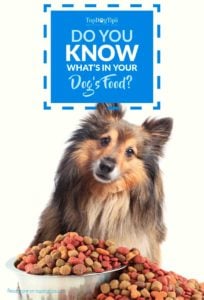 exactly what is in your dog's food is essential if you're trying to provide your pets with the best quality diet possible and ensure healthy living and longevity. Unfortunately, today's pet food marketing schemes make understanding dog food really difficult and pet owners are left confused.
exactly what is in your dog's food is essential if you're trying to provide your pets with the best quality diet possible and ensure healthy living and longevity. Unfortunately, today's pet food marketing schemes make understanding dog food really difficult and pet owners are left confused.
Over the years, pet food industry has been a subject of many controversies, lawsuits and debates. This means dog owners should always question everything about their pet's food.
I will walk you through the important factors to consider when picking out the best food for your dog and what matters the most. A few things you must consider first when choosing commercial dog food brands:
- the standards to which pet foods are held;
- the breakdown of ingredients including the definition of terms;
- the available forms of pet food and benefits of these forms.
Statements on Dog Food Packages
Many dog food formulas will have the statement “complete and balanced” on their packaging. According to FDA and their subsidiary CVM, in order to include a statement “complete and balanced” on pet food, the brand must either complete AAFCO feeding trials or contain the levels of each nutrient as specified by AAFCO.
Although many top dog food brands will often reference the AAFCO official publication, it is important to note that AAFCO is not a governing body. It's the science and research based nutritional standards that many legitimate pet food brands aim to meet.
Although a diet that completes AAFCO feeding trials is considered 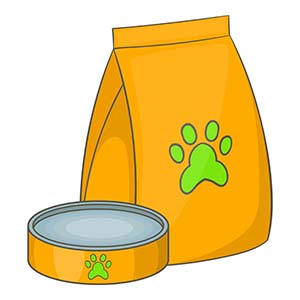 complete and balanced for nutrition for your pet, note that AAFCO only recognizes four life stages:
complete and balanced for nutrition for your pet, note that AAFCO only recognizes four life stages:
- Growth
- Maintenance
- Gestation
- Lactation
This means that there are currently no AAFCO-approved geriatric, senior, or weight loss diets. Even though there are some pet food manufacturers that brand their products as dog food for seniors or dog food for sensitive stomach, these are not AAFCO-approved.
Furthermore, specific veterinary therapeutic diets are not yet recognized by the publication either. In fact, prescription dog food diets have been under fire lately, with pet food companies fighting off lawsuits. Read more about prescription food controversy here.
Now that you understand what the term “complete and balanced” means, let's talk about the rules and regulations for pet food labeling. Reading dog food labels is the way that a majority of pet owners get information about the canine diet they're feeding their dog. That's why it's so important to know if you can trust the claims written on the label.
How Much Protein is Actually in Dog Food?
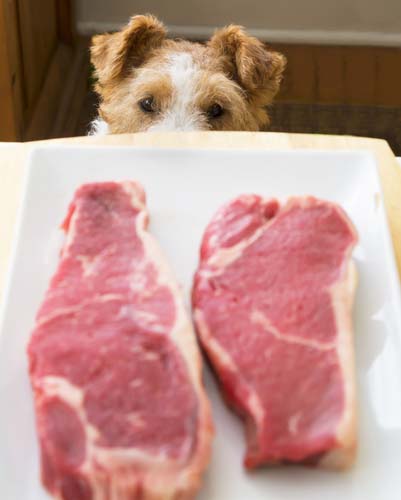 Pet food manufacturers have long been employing certain tricks to go around dog food labeling requirements, but many pet owners are unaware of these gimmicks. As a result, your dog may actually be getting less protein (because there's actually less real meat) than you are led to believe.
Pet food manufacturers have long been employing certain tricks to go around dog food labeling requirements, but many pet owners are unaware of these gimmicks. As a result, your dog may actually be getting less protein (because there's actually less real meat) than you are led to believe.
To start with, in order to interpret the ingredients listed on dog food packages, it is important that pet owners are able to interpret the definitions of the titles and names given to said ingredients. All titles on pet food packages must meet requirements monitored by the AAFCO.
The definitions of the ingredient titles must never vary from the AAFCO definition.
The use of ingredient names on dog food labels indicate the content of that ingredient in the recipe. For example, if you see the term “Chicken” used on a dog food package, that brand must contain at least 70% chicken in the total or less than 95% of the total weight of ingredients, less water.
“Chicken” vs “Chicken Dinner” vs “With Chicken” – what's the difference?
The difference is actually quite significant.
By using a term such as “Chicken Dinner” the product must contain at least 10% chicken in the total product and at least 25% with a maximum 95% of the total weight of all ingredients, less water.
By using the term “With Chicken” the implication is that there is only a subtle hint of chicken detected by taste. Therefore, in this instance only 3% of the total product is needed to be chicken.
Here's a quick cheat sheet on these three dog food label package terms:
| Statement | Percentage |
| “Chicken“ | At least 70% |
| “Chicken Dinner“ | At least 10% |
| “With Chicken“ | At least 3% |
As for the dog food weight, it must always be listed on the front of the pet food package label within the bottom third of the principal display panel; however, this is rarely the issue with pet owners.
How to Interpret Protein and Meat Sources?
 Protein and meat sources are the main ingredient in most dog food brands, and all pet owners want to ensure that their canines get enough meat from their kibble. When using the term “Meat” on dog food package labels, there are careful guidelines the manufacturer must follow.
Protein and meat sources are the main ingredient in most dog food brands, and all pet owners want to ensure that their canines get enough meat from their kibble. When using the term “Meat” on dog food package labels, there are careful guidelines the manufacturer must follow.
First of all, “Meat” may only be used for product derived from a mammalian species.
The pet food manufacturer may also include the species which was used as the source of meat. If the manufacturer chooses not to, the meat must only be sourced from sheep, pigs, goats or cattle. Any other meat source used in dog food such as venison or bison must always be named.
There are a few different ways that manufacturers can list protein sources on the label, including:
“Meat“ – This is primarily the meat of the muscle tissue of the animal, that is of the skeletal muscle, tongue, heart or esophagus. It may also include other tissue that would usually be found with the flesh such as overlying fat and epidermis, gristle, nerve, and blood vessels.
Although this meat may include less appealing cuts, it does not include bone or byproducts, and is similar to what would be purchased for human consumption.
“Meat By-products” – This is mainly made up of offal, including non-rendered but clean parts of the animal such as liver, blood and bone, stomachs and intestines and spleen. These are often meat products that may not be deemed fit for regular human consumption.
Meat byproducts are often considered unappealing; however, studies have shown them to be safe and very nutritious to dogs. They do not include hair, horns, teeth and hoofs.
“Poultry“ – This is primarily the muscle, skin and bone of the bird without the inclusion of feathers, heads, feet and entrails. This may however include backs, neck and bone of the birds.
“Poultry by-products” – These are the non-rendered clean parts of the bird carcass including heads, feet and viscera. Poultry byproducts should be as free from fecal content and foreign matter as good factory practice allows, according regulations.
ALSO READ: Expensive Dog Food Brands – Are They Worth the High Cost?
What is Rendered Meat in Dog Food?
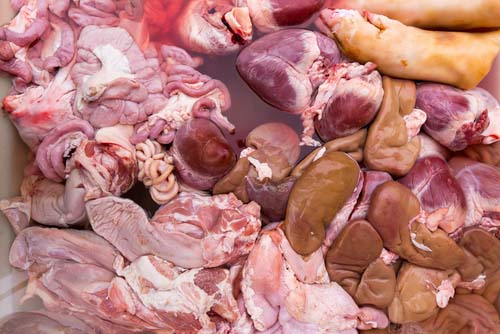 Rendered meat is a common ingredient in dog food. The process of rendering meat is designed to use heat to destroy disease-causing bacteria and applying pressure to remove water and fat content.
Rendered meat is a common ingredient in dog food. The process of rendering meat is designed to use heat to destroy disease-causing bacteria and applying pressure to remove water and fat content.
The rendering process leaves an ingredient that is high in both protein and minerals. This product can be from a range of animals. Unlike “Meat” products, the pet food manufacturer does not have to specify the species of derivation, which has been the cause of many controversies and debates among pet owners.
Whenever dog food includes rendered meat as ingredient, you will see the word “meal” on the label. There are several ways to list and name these dog foods:
“Meat meal“ – This is the ingredients that has been rendered from mammal tissue to produce meat source that excludes any added blood, hair, hoof, horn, hide trimmings, manure, stomach and rumen contents except what may be accidentally included despite good practice.
“Meat and bone meal“ – This describes the tissue that has been rendered from mammal tissues and may include bone. It excludes added blood, hair, hoof, horn, hide trimmings, manure, stomach and rumen contents except accidentally included despite good practice.
“Animal by-product meal” – This is the meat byproduct that has been rendered from mammal tissues and may include bone. It excludes added blood, hair, hoof, horn, hide trimmings, manure, stomach and rumen contents except those accidentally included despite best practice. It is accepted that as this form includes entire carcasses, by-products such as added blood, hoof and hair may be found as well.
“Poultry by-product meal“ – This term describes the rendered and ground clean parts of the bird carcass including heads, feet and viscera. It should be as free from fecal content and foreign matter as good factory practice allows.
“Poultry meal“ – This is primarily the muscle, skin and bone of the bird rendered and ground to form a dry meal without the inclusion of feathers, heads feet and entrails. This may include backs, neck and bone, however.
RELATED: Dog Food Prices – 30 Top Food Brands & Their Value Compared
Types of Dog Food (forms)
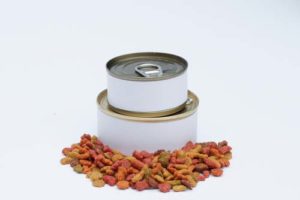 Complete and balanced dog foods are available in three popular types. The first and most popular dog food type is dry kibble. This is the most common form of pet food because it's cheapest to manufacture and easiest to give to pets. It contains high levels of dry matter (90%) and low levels of water (10%).
Complete and balanced dog foods are available in three popular types. The first and most popular dog food type is dry kibble. This is the most common form of pet food because it's cheapest to manufacture and easiest to give to pets. It contains high levels of dry matter (90%) and low levels of water (10%).
Dry kibble dog food is processed to destroy bacteria and toxins, and then the food is manufactured into easily digestible form. To increase palatability, kibble dog food is often coated with fat. Benefits of this form of pet food include lower price point, long shelf life and benefits to dental health during ingestion.
The second most popular type is canned dog food. It contains high levels of water (68%–78%) and low levels of dry matter (22%–32%). It's ideal for pets suffering from dehydration, kidney disease or other conditions that cause increased thirst.
Most vets often recommend wet dog food for canines with many health issues. Canned dog food is more expensive but it often contains higher amounts of meat, poultry and animal byproducts. The added water is actually beneficial to dogs with certain health conditions and wet dog food may be easier to digest for some.
Soft-moist food is the least popular type of dog food and is rarely purchased by pet owners unless there's a specific reason (such as dog's health condition). Soft-moist dog food contains 25%–40% water and 60%–75% dry matter. These foods are very convenient and often highly palatable for pets, however, they may be one of the most expensive pet food brands. They are an ideal diet for pets displaying anorexia.
ASK A VET: Does Hypoallergenic Dog Food Really Work and Why?


